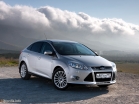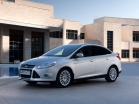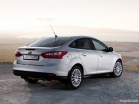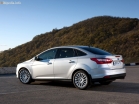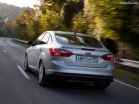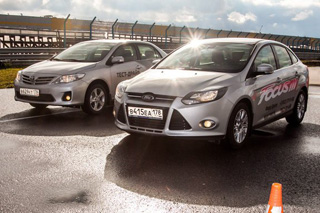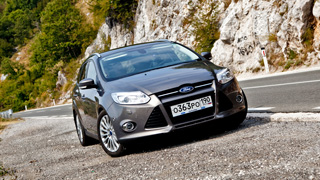Test drive Ford Focus sedan since 2010 sedan
Test drive Ford Focus and Suzuki SX4: Compact contradictions
 The issue of leadership in the small middle class segment was removed at the time of the start of the Ford Focus II production at the plant in Vsevolozhsk. But despite the voices of the ruble, annually leading a blue oval to new sales records, the Kolesa.ru portal is trying to find a car no less worthy than Focus. Maybe Suzuki SX4 will get?
The issue of leadership in the small middle class segment was removed at the time of the start of the Ford Focus II production at the plant in Vsevolozhsk. But despite the voices of the ruble, annually leading a blue oval to new sales records, the Kolesa.ru portal is trying to find a car no less worthy than Focus. Maybe Suzuki SX4 will get? The Japanese compact does not look like typical sedans of a small middle class: it has a short nose and feed, which is why the salon seems too large in volume. In addition, the SX4 sedan is less harmonious than its modification without a separate trunk. Ford, on the contrary, fully justifies the name of the style in which the kinetic design is made, and looks like a flying shell that is in the sedan body, which is a hatchback.
Of course, it is not worth saying that Ford has gone for years to come in terms of design. SX4 has stylish headlights and lanterns, a pretty additional plastic body kit for bumers and thresholds; Graceful stamping on wings. Focus is more colorful and stricter, in details and in general.
Ford designers and engineers have approached Suzuki’s colleagues and engineers to organize the interior. Combinations of gray and black plastic, various textures of materials and the catchy performance of the most seemingly ordinary tools, distinguishes Focus not only from SX4, but also from many other rivals.
Places in the second row are approximately the same in both cars. Unless the profile of the rear sofa Suzuki is more flat than in Focus. Due to this, three passengers in the Japanese will be more comfortable. But if passengers above the average height straighten their backs (in any of the sedans), they will earn their heads in the roof.
Suzuki trunk is noticeably larger than Focus in factory data indicates the advantage of the Japanese of 48 liters, but the severity in the Ford trunk is more convenient due to a much smaller loading height.
 How different cars these are from the first meters of the trip. The steering wheel in the SX4 can be rotated with one finger, while you can direct Focus by making some efforts. In the city, on the streets covered with snow, that on pure asphalt the focus is more obedient and understandable in handling a car.
How different cars these are from the first meters of the trip. The steering wheel in the SX4 can be rotated with one finger, while you can direct Focus by making some efforts. In the city, on the streets covered with snow, that on pure asphalt the focus is more obedient and understandable in handling a car. In a nutson, I would choose for the city, Suzuki for a summer residence. The SX4 suspension course seems much longer than Focus, although the Japanese road clearance is most centimeter. Ford is harsh and felt heavy, and the driver and passengers of Suzuki will feel much better on an uneven road; The suspension is worthy to cope with pits of different caliber. The inhabitants of Focus on bumps will not be so comfortable.
The element of a naturalized American from Vsevolozhsk is even asphalt and suburban speed. Focus is one of the best handling cars; The chassis reacts to the driver’s actions quickly and accurately. At high speeds, the SX4 does not hold a straight line, constantly demanding steering from the driver. But outside the settlement, the Japanese suspension is ready to forgive a small hole that came under the wheels: SX4 did not allow a single breakdown, having twice passing the M10 Moscow-Petersburg highway. Who traveled along this road will be imbued with the same respect for the Suzuki sedan as we
The 1.6-liter 100-horsepower Ford gasoline is living its last days: on the new Focus it will be replaced with more technological Duratec Ti-VCT with adjustable phases of gas distribution. Against the background of a sluggish Ford engine, the 111-horsepower Suzuki motor appears much more powerful. The SX4 gas pedal responds much faster, as if this is not a utilitarian sedan, but a hot hatchback. (By the way, in the car dealership, we were informed that for Focus you can order an unofficial option button, pressing which reduces the response time for the gas pedal. Naturally, you will have to pay an increased fuel consumption and, probably, the engine warranty.)
Suzuki gains 100 km/h for one and a half seconds faster than focus. And in terms of efficiency, Ford wins 0.4 liters only on the highway, yielding 0.8 liters in the city.
The sound of the engines of both cars does not annoy, especially at idle and medium engine speeds. Only at revolutions over 4,000 rpm. SX4 shouts an opponent.
 Ford Focus sedan in the minimum configuration costs 469,000 rubles. Such cars have a 1.4-liter engine and minimal equipment, and you can purchase them only by handing them out in exchange an old car according to the state utilization state program. A 1.6-liter sedan costs (at a special price) 560,000 rubles, and with an automatic checkpoint from 598,000 rubles.
Ford Focus sedan in the minimum configuration costs 469,000 rubles. Such cars have a 1.4-liter engine and minimal equipment, and you can purchase them only by handing them out in exchange an old car according to the state utilization state program. A 1.6-liter sedan costs (at a special price) 560,000 rubles, and with an automatic checkpoint from 598,000 rubles. Suzuki SX4 with four doors is sold no less than 584,000 rubles, and it cannot be changed to a 10-year collapse, since the machine is not produced in the Russian Federation. The specified price includes a 1.6-liter motor and mechanics, and the machine is available from 614,000 rubles.
Instead of a resume
Ford Focus will still remain the most popular foreign car in Russia and for a reason. Whoever was compared with. We came to the conclusion that the Suzuki SX4 is superior to the opponent in smooth driving on uneven surfaces, as well as strangely enough in accelerated dynamics among automated 1.6. But a brighter, stylish Ford design plus competent marketing policy and Russian citizenship (and hence participation in state programs, of course) outweighs. A colleague invited to the test, just choosing a car of this class-price category, was more interested in Focus. It is interesting that if you analyze the characteristics of the winner will be completely different. What proves once again: the success of the model depends not only on official numbers ...
Body length, mm
Ford Focus sedan 4 481
Suzuki SX4 sedan 4 490
Trunk volume, l
Ford Focus sedan 467
Suzuki SX4 sedan 515
Road clearance, mm
Ford Focus sedan 155
Suzuki SX4 sedan 165
Acceleration to 100 km/h, sec
Ford Focus sedan 13.7
Suzuki SX4 sedan 12.3
Cars for the test are provided LLC Suzuki Motor RUS and the official Ford dealer Ford Center Maximum.
Author: Alexander Korobchenko
Photo: Roman Ostanin

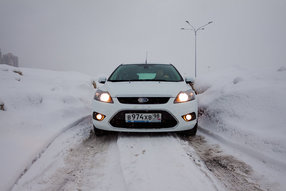
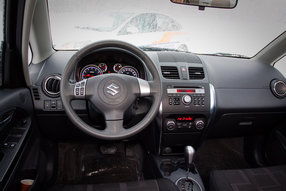



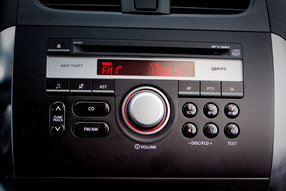



Source: Wheel magazine [January 2011]

